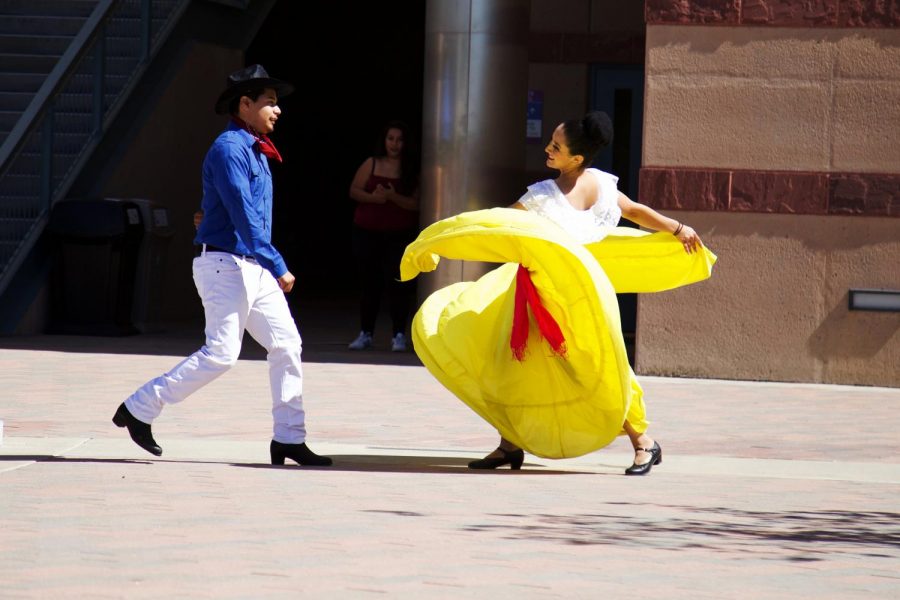Ballet Folklorico teaches diverse Mexican dances to students
Saul Rojas and Lorena Santiago performing a duet called El Coyote on Oct. 5 in front of University Hall.
October 12, 2017
Ballet Folklorico de CSUSM dances to teach students diversity.
On Oct. 5 Ballet Folklorico de CSUSM hosted, “La Raza del Folklore.” The organization held three tables where other student cultural groups taught students the differences of Mexican folklore in specific regions. Ballet Folklorico performed eight different dances.
Standing Together as oNe Dream (STAND) held a table about Queretaro, Ballet Folklorico de CSUSM held a table speaking about Jalisco, Sinaloa, and northern Baja California. Movimiento Estudiantil Chicano de Aztlan (MEChA) had a table about Nayarit.
Fourth-year student, Maria Sandoval is a member of Ballet Folklorico. Sandoval presented many of the dances.
“Folklorico is very diverse. Diverse in the sense of hair pieces, music, the beat, history behind it, rhythm… everything… that’s what we want to educate our peers,” said Sandoval.
Sandoval said the students who are performing are engaging by being involved on campus. Apart from their academics, the performers are also learning about the Mexican folklorico. “It’s something that I don’t think we teach in classes,” said Sandoval about educating students.
The event had free food for the first 100 people. They served rice, beans, chicken and pork tamales and horchata and hibiscus tea.
Sandoval presented David Chavez. Chavez spoke about Amalia Hernandez. Hernandez is a famous Mexican Choreographer. Hernandez created her own ballet folklorico school in 1952 named Ballet Folklorico de Mexico de Amalia Hernandez. Chavez said Hernandez inspired many people including himself.
The performance began with a dance from Sinaloa. The females wore orange, yellow, red and blue skirts. In other dances, the males joined and wore a blue shirt with white pants.
Three males and one female danced the second performance from Jalisco. All males in that dance were performing for the first time.
In a second dance performance for Jalisco called ‘Jarabe Tapatio,’ a male and female performed a duet.
Sandoval participated in three dances representing Baja California. They wore jeans, plaid shirts, and boots. They closed their performance with a well-known Spanish song called La Chona by Los Tucanes de Tijuana.
If interested in joining Ballet Folklorico de CSUSM, they practice every Tuesday and Thursday in the Arts Patio 361 from 6 p.m. to 9 p.m.








Gil Sperry • Oct 16, 2017 at 11:00 am
Felicidades on what you are doing to spread the word about …and the art of …ballet folklorico in your area.
We have just concluded our 8th Annual Rosarito Beach International Mariachi & Folklorico Festival, a benefit for our charity,The Boys and Girls Club of Rosarito. Kareli Montoya and her Ballet Folklorico de Los Angeles taught the three day Talleres (Workshops) in dance. Over 300 students from the United States, Mexico and Canada attended. We wouid like to invite you to consider attending our 9th Annual event which will run from October 3rd-6rh, 2018 at the iconic oceanfront Rosarito Beach Hotel.
You can find more information on what we do by visiting : http://www.clubrosarito.org
Please let me know if you have any questions.
At your service,
Gil Sperry
Teacher/Author
Official Goodwill Ambassador for Rosarito Beach
Member of The Baja Image Committee
Director of The Baja Times
Vice President of The Boys and Girls Club of Rosarito
Founder of the city’s Annual International Mariachi & Folklorico Festival
(661) 612-1244, (661) 613-0551, (661) 614-0335 or. in Cali (619) 887-9288